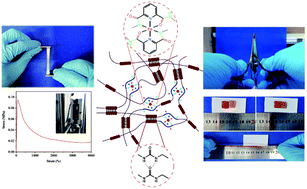A supramolecular polymer with ultra-stretchable, notch-insensitive, rapid self-healing and adhesive properties†
Abstract
Supramolecular elastomers, possessing excellent mechanical, reusable adhesivity, and rapid self-healing properties, are essential for use in various applications. Herein, we developed a novel polyamide-urea elastomer with metal–ligand interactions and hydrogen bonds forming synergetic double dynamic bonds. Physical crosslinking endows the polyamide-urea elastomer with extreme stretchability and rapid self-healing ability at room temperature. The representative polyamide-urea elastomer, DPPy1–Fe2, can be stretched to 40× its original length without breaking, and has extraordinary notch-insensitive elongation of up to 3500%. Meanwhile, DPPy1–Fe2 can fully restore its elasticity modulus within 5 min at room temperature, and the elongation also reaches 3000% after 30 min of healing. In addition, the unique dynamic bonds of the supramolecule enable it to repeatedly and firmly adhere to different surfaces. The shear strength of DPPy1–Fe2 is restored to an appreciable 80% after the first detachment–reattachment cycle, with it still possessing excellent adhesive strength after multiple cycles. As a result, the supramolecular elastomer shows outstanding stretchability, tear-resistance, quick self-repairing, and reusable adhesivity, which will facilitate the progress of intelligent adhesivity and flexible electronics.



 Please wait while we load your content...
Please wait while we load your content...